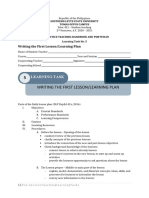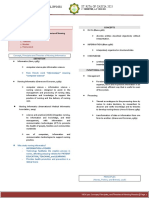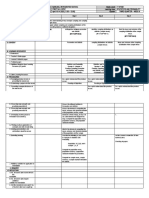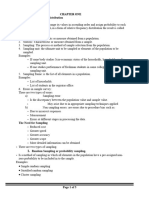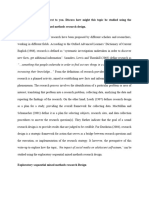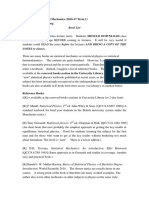STATISTICS Module LESSON 6
Uploaded by
Chris AlbanoSTATISTICS Module LESSON 6
Uploaded by
Chris AlbanoPage |1
IGAMA COLLEGES FOUNDATION INC.
Badoc, Ilocos Norte
STATISTICS AND PROBABILITY
Quarter 1 – Module 5
Grade 11
WEEK 5 – October 26-29, 2020
Name of Student:
Section:
Prepared by:
Ms. Kimberly Joy De la Cruz
Mr. Christopher D. Albano
Fill up the table and take a picture or scan this cover page and send it your teacher via messenger.
Date Received Activity Date Started Date Finished Date Submitted
Activity 1.1 A
Read Lesson 1
Try it Yourself 1.1
Read Summary of Key Ideas
Activity 2.1
Read Lesson 2
Try it Yourself 2.1
Read Summary of Key Ideas
Activity 3.1
Read Lesson 3
Try it Yourself 3.1
Read Summary of Key Ideas
MODULE IN STATISTISTICS AND PROBABILITY 11 | Prepared by: KJDC & CDA
Page |2
MODULE CONTENT
UNIT OF COMPETENCY : First Semester Statistics and Probability 11
MODULE TITLE : Sampling and Sampling Distribution
MODULE DESCRIPTION : a. illustrates random sampling
b. distinguishes between parameter and
statistic.
c. identifies sampling distributions of statistics
(sample mean).
NOMINAL DURATION : 1 week
SUMMARY OF LEARNING OUTCOMES
At the end of this module the learner demonstrates understanding of key concepts
of sampling and sampling distribution.
1. Sampling Distribution of Sample Means
ASSESSMENT METHOD : Demonstration of solution to the
problems
LO1. Enhancing Knowledge of Probabilities under the Normal Curve
CONTENT:
1. Demonstration on how to solve proportions of areas under the normal curve
CONDITIONS:
The students will have access to:
Module on Statistics and Probability 11
Activity Sheets
METHODOLOGIES:
Blended Learning
ASSESSMENT METHODS:
Activity
Try it Yourself
INTRODUCTION
We have learned in our previous lessons how to construct the probability distribution of a
discrete random variable. We have also learned how to compute the mean and the standard
deviation of a discrete random variable. We shall apply these concepts wherein we shall study
another probability distribution—the probability distribution of the sample means, popularly
known as the sampling distribution of the sample means. The study of sampling distribution of the
sample means will be the basis for making statistical inferences and testing hypotheses.
LESSON 1
Sampling Distribution of the Sample Mean
At the end of the lesson, you are expected to
illustrate random sampling
distinguish between parameter and statistics
identify sampling distribution of sample means
In conducting a research, the use of samples to acquire information is more convenient and
more feasible than using the entire population. The use of sample is generally less costly and more
MODULE IN STATISTISTICS AND PROBABILITY 11 | Prepared by: KJDC & CDA
Page |3
practical. However, we cannot expect the sample to yield accurate information about the
population. We should expect a certain amount of error from using the sample. This error is called
sampling error.
In this lesson, we shall learn how to construct the sampling distribution of sample means and
in the succeeding lessons we shall find out some important characteristics of the sampling
distribution of the sample means. This will eventually help us to understand the process of making
statistical inferences about the population, using a sample drawn from it.
To prepare you to this lesson, do the activities that follow.
Activity 1.1
A. A sample of investment experts was asked to give their opinion as to where they would invest
their money. The following are their responses.
Stocks Real estate Real estate
Precious metals Art Precious metals
Real estate Precious metals Commodities
Art Precious metals Foreign money
Precious metals Commodities Commodities
Stocks Foreign money Stocks
Stocks Stocks Real estate
Real estate Stocks Real estate
Commodities Stocks Real estate
Stocks Precious metals Real estate
Real estate Real estate Foreign money
Construct a table to show the frequency distribution of the given responses.
Type of Investment Frequency
B. Recall from our study of probability that the number of combinations of n objects taken r at a
time is obtained by using the formula.
( ) where
( )
Evaluate the following:
1. ( ) 4. ( )
2. ( ) 5. ( )
3. ( )
C. Find the mean of the following sets of data.
Set of Data Mean
1. 18, 19, 20, 21, 22, 21, 20, 19, 17, 17, 16, 16, 16
2. 5, 3, 6, 9, 7, 2, 10, 8
3. 18, 16, 19, 22, 20, 15, 23, 21, 21
4. 76, 69, 63, 82, 29, 83, 64, 71, 76
5. 36, 37, 37, 38, 23, 30, 35
MODULE IN STATISTISTICS AND PROBABILITY 11 | Prepared by: KJDC & CDA
Page |4
Definition
Sampling Distribution of the Sample Means
Suppose we have a population of size N with a mean , and we draw or select all possible
samples of size n from this population. Naturally, we expect to get different values of the means for
each sample. The sample means may be less than, greater than, or equal to the population mean
The sample means obtained will form a frequency distribution and the corresponding
probability distribution can be constructed. This distribution is called the sampling distribution of
the sample means.
How do we construct the sampling distribution of the sample means? Study the following
examples.
Example 1
A population consists of five values (Php 2, Php 3, Php 4, Php 5, Php 6). A sample of size 2 is to
be taken from this population.
a. How many samples are possible? List them and compute the mean of each sample.
b. Construct the sampling distribution of the sample means.
c. Construct the histogram of the sampling distributions of the sample means.
Solution:
1. Since the size of the population is we have . We shall draw a sample of size from this
population, so . Thus, the number of possible samples of size that can be drawn form
this population is computed as follows:
( )
( )
( )
( )
The number of all possible samples of size 2 is 10. The table below shows the list of all possible
samples with their corresponding means.
Possible Samples of Size 2 Mean
2, 3 2.5
2, 4 3.0
2, 5 3.5
2, 6 4.0
3, 4 3.5
3, 5 4.0
3, 6 4.5
4, 5 4.5
4, 6 5.0
5, 6 5.5
Observe that the means of the samples vary from sample to sample. The mean of the population
while the means of the samples may be less than, greater than, or equal to 4.
2. We now construct the frequency distribution of the sample means.
Mean Frequency
2.5 1
3.0 1
3.5 2
4.0 2
4.5 2
5.0 1
5.5 1
MODULE IN STATISTISTICS AND PROBABILITY 11 | Prepared by: KJDC & CDA
Page |5
Total 10
Next, we construct the probability distribution of the sample means. This is the sampling
distribution of the sample means.
Mean Probability ( ̅ )
2.5
3.0
3.5
4.0
4.5
5.0
3. The histogram of the sampling distribution of the sample means is constructed by making a bar
graph where the sample means are plotted on the horizontal axis and the corresponding
probabilities are shown in the vertical axis.
̅)
Probability (𝑿
Salary
𝟐𝟓 𝟑𝟎 𝟑𝟓 𝟒𝟎 𝟒𝟓 𝟓𝟎 𝟓𝟓
Example 2
The following tables gives the monthly (in thousands of pesos) of six officers in a government
office. Suppose that random samples of size 4 are taken from this population of six officers.
Officer Salary
A 8
B 12
C 16
D 20
E 24
F 28
1. How many samples are possible? List them and compute the mean of each sample.
2. Construct the sampling distribution of the sample means.
3. Construct the histogram of the sampling distribution of the sample means.
Solution
1. Since the size of the population is , we have . We shall draw a sample of size from
population, so Thus, the number of possible samples of size 4 that can be drawn from
this population is computed as follows.
( )
( )
( )
( )
MODULE IN STATISTISTICS AND PROBABILITY 11 | Prepared by: KJDC & CDA
Page |6
The number of all possible samples of size 4 is 15. The table below shows the list of all possible
samples with their corresponding means.
Sample Salaries Mean
A, B, C, D 8, 12, 16, 20 14
A, B, C, E 8, 12, 16, 24 15
A, B, C, F 8, 12, 16, 28 16
A, B, D, E 8, 12, 20, 24 16
A, B, D, F 8, 12, 20, 28 17
A, B, E, F 8, 12, 24, 28 18
A, C, D, E 8, 16, 20, 24 17
A, C, D, F 8, 16, 20, 28 18
A, C, E, F 8, 16, 24, 28 19
A, D, E, F 8, 20, 24, 28 20
B, C, D, E 12, 16, 20, 24 18
B, C, D, F 12, 16, 20, 28 19
B, C, E, F 12, 16, 24, 28 20
B, D, E, F 12, 20, 24, 28 21
C, D, E, F 16, 20, 24, 28 22
Observe that the means of the samples vary from sample to sample. The mean of the population
while the means of the samples may be less than, greater than, or equal to 18.
2. We now construct the frequency distribution of the sample means.
Mean Frequency
14 1
15 1
16 2
17 2
18 3
19 2
20 2
21 1
22 1
Total 15
Next, we construct the probability distribution of the sample means. This is the sampling
distribution of the sample means.
Mean ̅ Probability ( ̅ )
14
15
16
17
18
19
20
21
MODULE IN STATISTISTICS AND PROBABILITY 11 | Prepared by: KJDC & CDA
Page |7
22
Total 15
3. The histogram of the sampling distribution of the sample means is constructed by making a bar
graph where the sample means are plotted on the horizontal axis and the corresponding
probabilities are shown in the vertical axis.
𝟓
̅)
Probability (𝑿 𝟒
𝟑
𝟐
𝟏
𝟎
𝟏𝟒 𝟏𝟓 𝟏𝟔 𝟏𝟕 𝟏𝟖 𝟏𝟗 𝟐𝟎 𝟐𝟏 𝟐𝟐
TRY IT YOURSELF 1.1
A. Determine the number of different samples of the given size 𝒏 that can be drawn
from the given population of size 𝑵.
N n Number of Possible Samples
8 4
10 2
60 6
B. Random samples of size 𝑛 are drawn from a finite population consisting of the
numbers and .
a. How many possible samples are there?
b. List all the possible samples and the corresponding mean for each sample.
c. Construct the sampling distribution of the sample means.
d. Construct the histogram for the sampling distribution of the sample
means. Describe the shape of the histogram.
Summary of Key Ideas
1. The number of possible samples of size n that can be drawn from a population of
size N is 𝐶(𝑁 𝑛) where
𝑁
𝐶 (𝑁 𝑛) (𝑁 𝑛) where 𝑁 𝑛
2. The sampling distribution of sample means is frequency distribution of the sample
means taken from a population.
3. The histogram of the sampling distribution of the sample means is a bar graph
constructed by plotting the sample means along the horizontal axis and the
probabilities along the vertical axis.
References:
Books
Belecina, R.R., Baccay, E.S. & Mateo, E.B. (2016). Statistics and Probability. Sampaloc Manila: Rex Book Store, Inc.
Marquez, W.G & Ocampo, Jr., J.M. (2016). Conceptual Math and Beyond Statistics and Probability. Novaliches, Quezon
City: Brilliant Creations Publishing, Inc.
Electronic Device
Stephanie Glen. "Normal Distributions (Bell Curve): Definition, Word Problems" from StatisticsHowTo.com: Elementary
Statistics for the rest of us! https://www.statisticshowto.com/probability-and-statistics/normal-distributions/
MODULE IN STATISTISTICS AND PROBABILITY 11 | Prepared by: KJDC & CDA
Page |8
MODULE IN STATISTISTICS AND PROBABILITY 11 | Prepared by: KJDC & CDA
Prepared by: Ms. Kimberly Joy De la Cruz
Statistics and Probability: Sampling and Sampling Distribution
Mr. Christopher D. Albano ICFI
Name: __________________________________ Year & Section: _____________
Date Started: _____________________ Date Finished: _______________
INSTRUCTIONS. Answer the following.
A. Determine the number of different samples of the given size n that an be drawn from the given
population of size N.
N n Number of Possible Samples
10 3
32 6
40 5
B. Random samples of size are drawn from a finite population consisting of the numbers
and .
a. How many possible samples are there?
b. List all the possible samples and the corresponding mean for each sample.
c. Construct the sampling distribution of the sample means.
d. Construct the histogram for the sampling distribution of the sample means. Describe the
shape of the histogram.
Activity Worksheet: Sampling Distribution of the Sample Means Page 9 of 16
You might also like
- Olympiad Sample Paper 2: Useful for Olympiad conducted at School, National & International levelsFrom EverandOlympiad Sample Paper 2: Useful for Olympiad conducted at School, National & International levels5/5 (4)
- St. Paul University Philippines St. Rita of Cascia 2023No ratings yetSt. Paul University Philippines St. Rita of Cascia 20236 pages
- Suneeta Monga, Diane Benoit - Assessing and Treating Anxiety Disorders in Young Children - The Taming Sneaky Fears Program-Springer International Publishing (2018)No ratings yetSuneeta Monga, Diane Benoit - Assessing and Treating Anxiety Disorders in Young Children - The Taming Sneaky Fears Program-Springer International Publishing (2018)228 pages
- q4 Sampling and Sampling Dist. Stat. and ProbNo ratings yetq4 Sampling and Sampling Dist. Stat. and Prob4 pages
- E-Note_24354_Content_Document_20240917024357PMNo ratings yetE-Note_24354_Content_Document_20240917024357PM4 pages
- Atg3 - Stat&prob - 2ND Sem - Sy22-23 - GcesguerraNo ratings yetAtg3 - Stat&prob - 2ND Sem - Sy22-23 - Gcesguerra10 pages
- E-Note 20895 Content Document 20240607120458PMNo ratings yetE-Note 20895 Content Document 20240607120458PM202 pages
- Lecture Guide in Math009: Probability and Statistics0% (1)Lecture Guide in Math009: Probability and Statistics44 pages
- Statistics & Probability: CRT Learning ModuleNo ratings yetStatistics & Probability: CRT Learning Module17 pages
- Statistics-and-probability-CHAPTER-3-CopyNo ratings yetStatistics-and-probability-CHAPTER-3-Copy77 pages
- Statistics and Probability Daily Lesson Log100% (2)Statistics and Probability Daily Lesson Log3 pages
- Mathematics Literacy - Formative Assessment 1_awkNo ratings yetMathematics Literacy - Formative Assessment 1_awk19 pages
- CS_RS12-IIa-c-2-G12-WS-Q2-W1-PR2-Sample-Size-and-Sampling-ProcedureNo ratings yetCS_RS12-IIa-c-2-G12-WS-Q2-W1-PR2-Sample-Size-and-Sampling-Procedure4 pages
- A241 SQQSK1013 Group Assignment Instruction - For StudentNo ratings yetA241 SQQSK1013 Group Assignment Instruction - For Student7 pages
- LP Chapter 4 Lesson 4 Confidence Interval Estimation of The Population Mean (Part 2)No ratings yetLP Chapter 4 Lesson 4 Confidence Interval Estimation of The Population Mean (Part 2)3 pages
- Lesson Plan in Grade 11 Statistics and Probability100% (1)Lesson Plan in Grade 11 Statistics and Probability7 pages
- Math 10 Note Pack With Practice Summer 2016No ratings yetMath 10 Note Pack With Practice Summer 201697 pages
- Unit 3 Probability Distributions: StructureNo ratings yetUnit 3 Probability Distributions: Structure38 pages
- (3rd Month) MATH 112 - Statistics and ProbabilityNo ratings yet(3rd Month) MATH 112 - Statistics and Probability65 pages
- Module Contents: Introduction To Statistics and ProbabilityNo ratings yetModule Contents: Introduction To Statistics and Probability10 pages
- Study Manual Mizan Sir - Economics & StatisticsNo ratings yetStudy Manual Mizan Sir - Economics & Statistics249 pages
- Distance-Learning-Course-Plan Math1-StatisticsNo ratings yetDistance-Learning-Course-Plan Math1-Statistics13 pages
- Olympiad Sample Paper 3: Useful for Olympiad conducted at School, National & International levelsFrom EverandOlympiad Sample Paper 3: Useful for Olympiad conducted at School, National & International levels1/5 (1)
- Strengths, Weaknesses, Opportunities, and ThreatsNo ratings yetStrengths, Weaknesses, Opportunities, and Threats4 pages
- Application of The Maslow's Hierarchy of Need Theory ImpactsNo ratings yetApplication of The Maslow's Hierarchy of Need Theory Impacts8 pages
- Mindfulness and Interpersonal CommunicationNo ratings yetMindfulness and Interpersonal Communication23 pages
- Career Exploration Student Activity PacketNo ratings yetCareer Exploration Student Activity Packet4 pages
- WT Determiningidentifying and Illustrating An Arithmetic SequenceNo ratings yetWT Determiningidentifying and Illustrating An Arithmetic Sequence5 pages
- Topic 8-Chapter 12-Motivating Employees Achieving Superior Performance in The WorkplaceNo ratings yetTopic 8-Chapter 12-Motivating Employees Achieving Superior Performance in The Workplace49 pages
- Construction of An Objective Skill Test For Lay-Up Shot in BasketballNo ratings yetConstruction of An Objective Skill Test For Lay-Up Shot in Basketball2 pages
- WEEK 1 DAY 4 Composition and Structure of MeatNo ratings yetWEEK 1 DAY 4 Composition and Structure of Meat3 pages
- ! Cognitive Behavioural Therapy Self Help CourseNo ratings yet! Cognitive Behavioural Therapy Self Help Course54 pages
- 3.1. Verbal Communication: Written and - Oral Communication: Chapter Three Media of CommunicationNo ratings yet3.1. Verbal Communication: Written and - Oral Communication: Chapter Three Media of Communication6 pages
- Houlgate Kant Nietzsche and The Thing Itself100% (1)Houlgate Kant Nietzsche and The Thing Itself43 pages
- Olympiad Sample Paper 2: Useful for Olympiad conducted at School, National & International levelsFrom EverandOlympiad Sample Paper 2: Useful for Olympiad conducted at School, National & International levels
- St. Paul University Philippines St. Rita of Cascia 2023St. Paul University Philippines St. Rita of Cascia 2023
- Suneeta Monga, Diane Benoit - Assessing and Treating Anxiety Disorders in Young Children - The Taming Sneaky Fears Program-Springer International Publishing (2018)Suneeta Monga, Diane Benoit - Assessing and Treating Anxiety Disorders in Young Children - The Taming Sneaky Fears Program-Springer International Publishing (2018)
- Lecture Guide in Math009: Probability and StatisticsLecture Guide in Math009: Probability and Statistics
- CS_RS12-IIa-c-2-G12-WS-Q2-W1-PR2-Sample-Size-and-Sampling-ProcedureCS_RS12-IIa-c-2-G12-WS-Q2-W1-PR2-Sample-Size-and-Sampling-Procedure
- A241 SQQSK1013 Group Assignment Instruction - For StudentA241 SQQSK1013 Group Assignment Instruction - For Student
- LP Chapter 4 Lesson 4 Confidence Interval Estimation of The Population Mean (Part 2)LP Chapter 4 Lesson 4 Confidence Interval Estimation of The Population Mean (Part 2)
- Lesson Plan in Grade 11 Statistics and ProbabilityLesson Plan in Grade 11 Statistics and Probability
- Module Contents: Introduction To Statistics and ProbabilityModule Contents: Introduction To Statistics and Probability
- Olympiad Sample Paper 3: Useful for Olympiad conducted at School, National & International levelsFrom EverandOlympiad Sample Paper 3: Useful for Olympiad conducted at School, National & International levels
- Application of The Maslow's Hierarchy of Need Theory ImpactsApplication of The Maslow's Hierarchy of Need Theory Impacts
- WT Determiningidentifying and Illustrating An Arithmetic SequenceWT Determiningidentifying and Illustrating An Arithmetic Sequence
- Topic 8-Chapter 12-Motivating Employees Achieving Superior Performance in The WorkplaceTopic 8-Chapter 12-Motivating Employees Achieving Superior Performance in The Workplace
- Construction of An Objective Skill Test For Lay-Up Shot in BasketballConstruction of An Objective Skill Test For Lay-Up Shot in Basketball
- 3.1. Verbal Communication: Written and - Oral Communication: Chapter Three Media of Communication3.1. Verbal Communication: Written and - Oral Communication: Chapter Three Media of Communication

